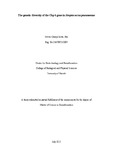| dc.description.abstract | Streptococcus pneumoniae (pneumococcus) is a common human pathogen
responsible for morbidity and mortality worldwide. It causes mild to life-threatening,
inflammatory diseases such as otitis media, pneumonia, sepsis and meningitis. The
prevention and management of pneumococcal infections has been very challenging.
Over time there has been increasing drug resistance of pneumococcus strains against
the available antibiotics. Moreover, the pneumococcal vaccines currently available in
the market do not offer broad coverage against the more than 90 serotypes currently
identified. If novel treatment and preventative strategies are not adopted soon, then
pneumococcal disease will continue to devastate human populations, especially in the
developing countries where it causes the most damage. This study comprised of 213
fully annotated complete genome sequences of S. pneumoniae downloaded from
GenBank. Amino acid and nucleic acid sequences of Choline binding protein A
(CbpA) were successfully extracted from 211 genomes (99%) for study of genetic
variation and identification of possible conserved, immunogenic regions eligible for
novel vaccine targets. Multiple SequenCe alignment by Log-Expectation (MUSCLE)
was used for alignment and the phylogenetic trees and heat maps created by PhyML
and R respectively. The CbpA locus was found to be highly polymorphic at both the
nucleic acid and amino acid sequences. However, RaptorX server showed that 83.3%
of the pneumococcal protein domains predicted were the conserved modular teichoic
acid phosphorylcholine esterase Pce (2bib:A) and the CbpA R2 domain (1w9r:A).
Using Transmembrane Hidden Markov Model (TMHMM) server and VaxiJen v 2.0
server, these conserved domains were shown to be extracellularly located and
immunogenic. The high variability observed in CbpA suggests its importance as a
natural target for host defense and essential element for the colonization of different
niches within the host. Further evaluation of 2bib:A and 1w9r:A conserved regions
would be required to design novel, efficacious, serotype- independent CbpA- fusion
protein vaccine candidate. | en_US |

